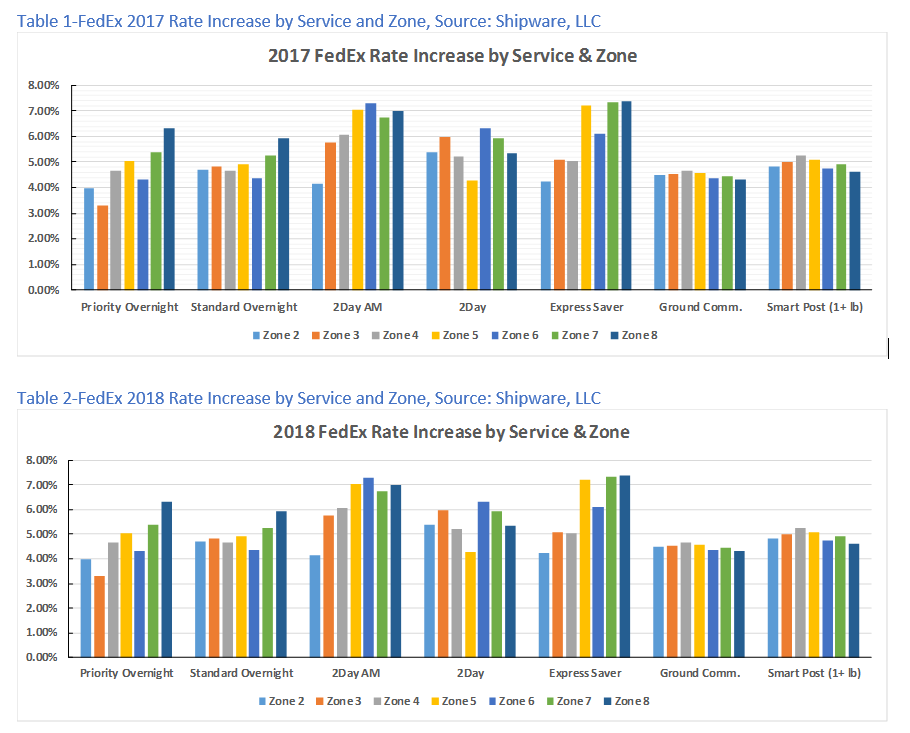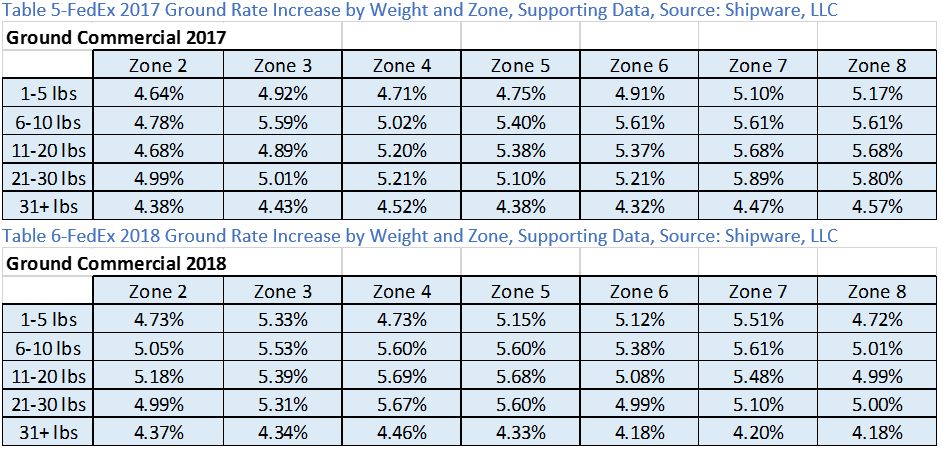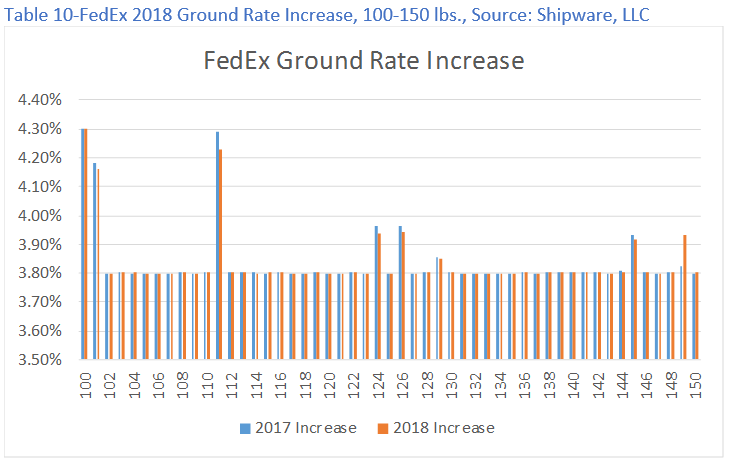As has been widely reported in many industry trade journals, FedEx Corp announced that it will be raising shipping rates in 2018 for FedEx Ground, FedEx Express, and FedEx Freight by 4.9%. If that number sounds familiar, it should. Here are the FedEx announced average rate increases for the past few years:
- 2017: 4.9% for Ground, 3.9% for Express
- 2016: 4.9% for Ground and Express
- 2015: 4.9% for Ground and Express
- 2014: 4.9% for Ground, 3.9% for Express
- 2013: 5.9% for Ground and Express (to be offset by fuel surcharge reduction)
- 2012: 5.9% for Ground and Express (to be offset by fuel surcharge reduction)
- 2011: 5.9% for Ground and Express (to be offset by fuel surcharge reduction)
- 2010: 4.9% for Ground, 5.9% for Express (to be offset by fuel surcharge reduction)
Notice a trend? Since the carriers (UPS and FedEx) began announcing an annual general rate increase (GRI), they’ve been consistent in their announced average increase. Those of you who have been paying attention over the years and who have either been able to quantify the true impact of the increase to your business or those who have hired a consultant to help you do so know that there is likely little relationship between that true impact number and the carriers’ announced average increase. You probably also understand that not all 4.9% rate increases are created equal.
As stated above, the announced average increase for Ground in 2017 was 4.9%, the same as the announced average increase for 2018. Below are two charts (Tables 1 and 2) comparing the actual increase by service level and zone for 2017 and for 2018. Initially, they look very similar, sharing the following trends:
- Lower increases on shorter zones
- Lower increases on Overnight relative to 2 Day and 3 Day
- Lower increases on Ground relative to all express services (except for a few exceptions on express services to shorter zones.)

However, let’s look at the Ground increase a little more granularly. Below are two charts (Tables 3 and 4) showing the increase to Ground rates by weight and zone for 2017 and 2018 along with some supporting data (Tables 5 and 6.) Here you can start to see the discrepancies between the two increases from one year to the next.


Notice the higher increases in Zone 8 for every weight group in 2017 as compared to 2018. But also, notice the higher increase in 2018 for every zone except Zone 8 for packages weighing between one and five pounds. The one notable similarity is the relatively low percentage of the increase burden being shared by packages weighing more than 31 lbs. And this is a key point.
When you look at the increase, year after year, on packages weighing less than 30 lbs., you can see that it’s consistently at or above the announced increase of 4.9%, with most increases coming above five percent and many pushing six percent. How, then, do the carriers get to claim that the average is only 4.9%? The answer is, primarily by lowering the increase on heavier weight packages. And consider that we’re talking about a very wide range of weights as packages weighing more than 30 lbs. include packages weighing from 31 lbs. all the way up to 150 lbs.! The chart below (Table 7) illustrates how the “tail” on the increase keeps the average increase at 4.9% even though the real impact to most shippers, who rarely ship packages weighing more than 20 lbs., is much higher.

Here’s a closer look at the impact of the rate increase on packages weighing 21 lbs. or less (Table 8) for the past two years. Considering that this is where most ground shipping volume is concentrated, you can see that 4.9% is probably not a fair representation of the true impact of the increase to most shippers as most of these increases are above five percent.

If you’re one of the rare shippers whose packages weigh more than 50 lbs., the news is better. Your increases are all below the announced average of 4.9% (Table 9).

And if your packages weigh more than 100 lbs., you’re in luck. Your increase by weight is consistently below four percent. (Table 10)

Minimum Net Charge
As any lightweight ground shipper with competitive discounts knows, a sizable percentage of their volume is probably being billed at the carriers’ minimum net charge. Those shippers also know that the minimum net charge has increased more than 80% over the past 10 years. The minimum net charge for a FedEx Ground package in 2018 will be $7.58, up from $7.25 in 2017. This is an increase of 4.6%. The two-year increase for the Ground minimum net charge is 9.2%. (Note that the minimum net charge for Ground has increased by 99% since 2006, when the charge was $3.90!)
Surcharges and Fees
Surcharges and other special handling fees are also increasing in 2017 as they consistently have for years now. Many of these surcharges will see a double-digit percentage increase. The Oversize Charge will see a 10.3% increase in 2018, after seeing a 7.4% increase last year. The Additional Handling charge will increase by 9.1% this year, and Residential Surcharges for Express and Ground will increase by 7.8% this year. The percentage increases for 2018 for a few of the more common surcharges are listed below along with their two-year increase. There’s been a two-year increase of almost 20% for the Oversize Charge!
Not included in the chart below (Table 11), but also worth noting is that FedEx announced that they will begin applying a 2.5% surcharge to the total cost of all third-party shipments in 2018, aligning them with UPS.

As was discussed here, FedEx will begin applying a dimensional weight divisor of 139 on all SmartPost packages in 2018. This is potentially a huge increase for SmartPost shippers. Consider the following examples (Table 12) using typical box sizes and weights. While the weight increase due to the application of DIM on these packages is relatively small, only between one and four pounds, the percentage rate increase is significant, between 12 and 53%!
Also, consider this: The sweet spot for most SmartPost packages from a least cost perspective relative to Home Delivery is usually nine pounds and under. With most SmartPost pricing programs, the cost advantage of SmartPost over Home Delivery starts to erode once you get above nine pounds. Now look at the last package in Table 12. At an actual weight of six pounds, it’s right in the SmartPost zone. But once DIM is applied, the billed weight becomes 10 lbs., meaning it should potentially be routed to Home Delivery based on least cost. So, if you’re not capturing the impact of DIM at manifest, you’re potentially making routing errors.
(UPS applies a 139 divisor to their SurePost product on packages larger than one cubic foot and a 166 divisor on packages less than one cubic foot. As of this writing, UPS had not made their 2018 rate announcement.)

Conclusion
Every shipping profile will be impacted differently by the rate increase. A thorough and deep understanding of your package characteristics and shipping profile is critical to being able to measure the impact to your organization. Contact Shipware for a custom analysis using your actual package data.
Dave Sullivan is a Senior Consultant for Shipware, LLC, a San Diego based parcel consulting firm. Dave has over 17 years of experience in logistics and transportation with a keen understanding for how the carriers structure margin-based parcel contracts. Dave also has extensive experience in LTL contract and rate structure, parcel network design and contract negotiation. Dave has dedicated his career to assisting well-known companies dramatically reduce their shipping costs.

















